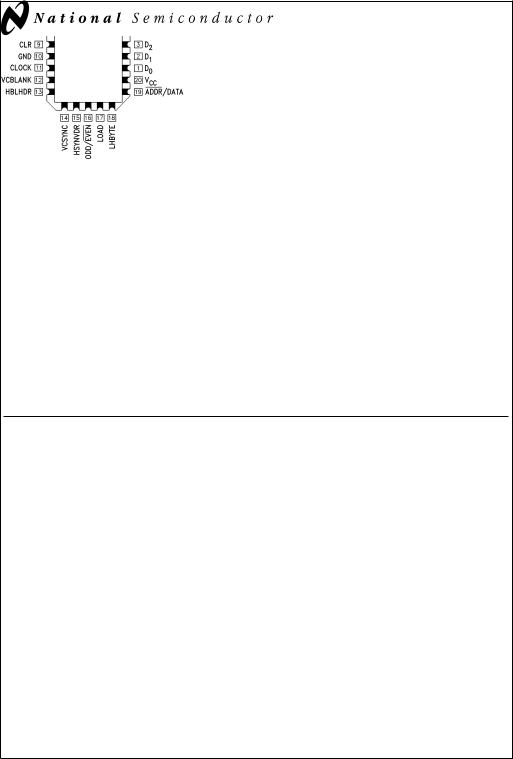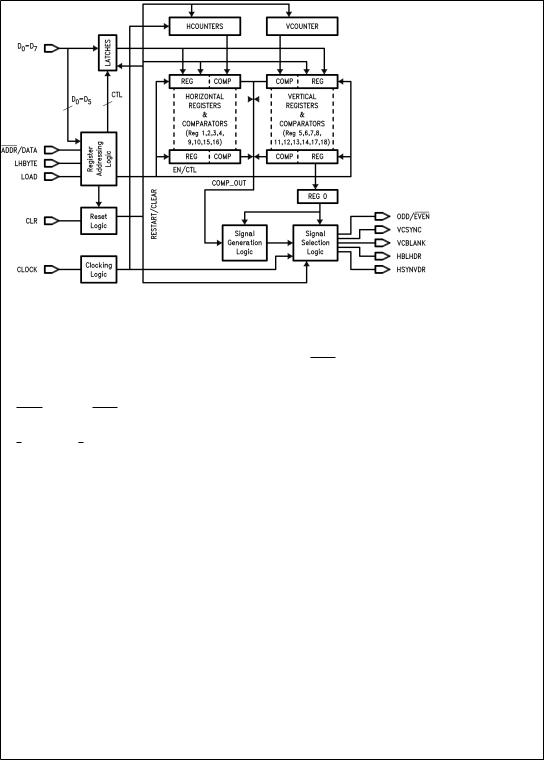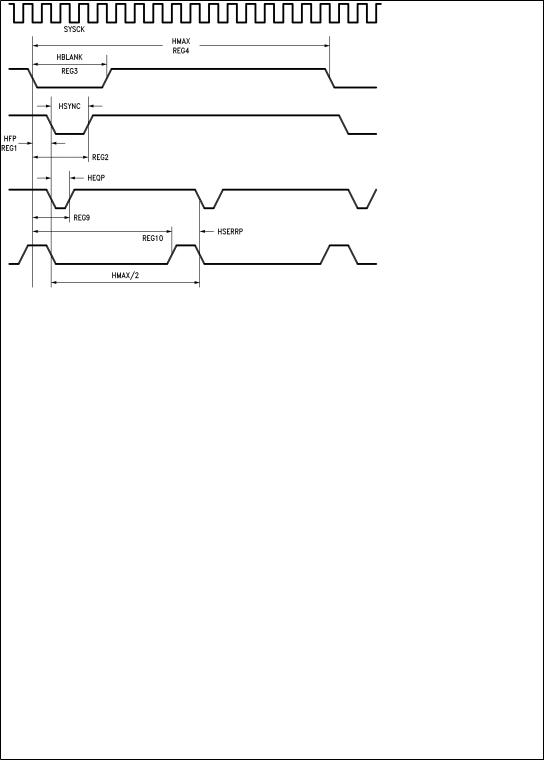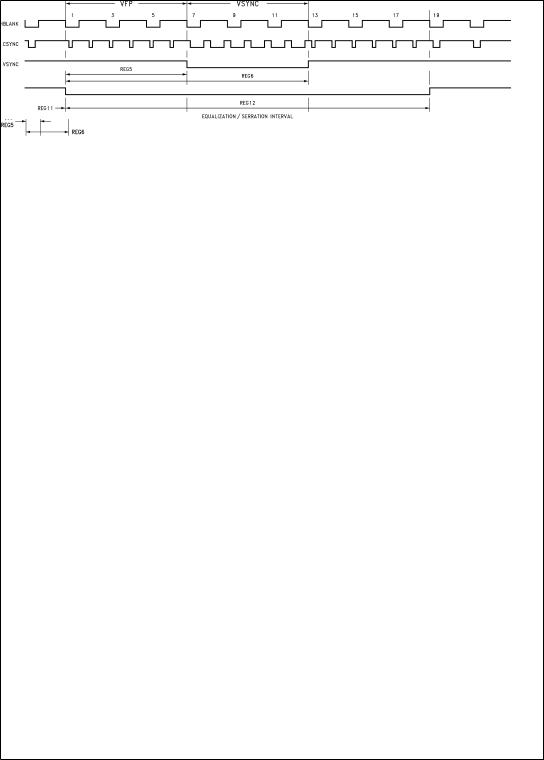NSC LM1882CN, LM1882CMX, LM1882-RCN, LM1882-RCMX, LM1882-RCM Datasheet
...
December 1998
LM1882·54ACT715
LM1882-R·54ACT715-R Programmable Video Sync
Generator
General Description
The 'ACT715/LM1882 and 'ACT715-R/LM1882-R are 20-pin TTL-input compatible devices capable of generating Horizontal, Vertical and Composite Sync and Blank signals for televisions and monitors. All pulse widths are completely definable by the user. The devices are capable of generating signals for both interlaced and noninterlaced modes of operation. Equalization and serration pulses can be introduced into the Composite Sync signal when needed.
Four additional signals can also be made available when Composite Sync or Blank are used. These signals can be used to generate horizontal or vertical gating pulses, cursor position or vertical Interrupt signal.
These devices make no assumptions concerning the system architecture. Line rate and field/frame rate are all a function of the values programmed into the data registers, the status register, and the input clock frequency.
The 'ACT715/LM1882 is mask programmed to default to a Clock Disable state. Bit 10 of the Status Register, Register 0, defaults to a logic ª0º. This facilitates (re)programming before operation.
The 'ACT715-R/LM1882-R is the same as the 'ACT715/ LM1882 in all respects except that the 'ACT715-R/
LM1882-R is mask programmed to default to a Clock Enabled state. Bit 10 of the Status Register defaults to a logic ª1º. Although completely (re)programmable, the 'ACT715-R/ LM1882-R version is better suited for applications using the default 14.31818 MHz RS-170 register values. This feature allows power-up directly into operation, following a single CLEAR pulse.
Features
nMaximum Input Clock Frequency > 130 MHz
nInterlaced and non-interlaced formats available
nSeparate or composite horizontal and vertical Sync and Blank signals available
nComplete control of pulse width via register programming
nAll inputs are TTL compatible
n8 mA drive on all outputs
nDefault RS170/NTSC values mask programmed into registers
n4 KV minimum ESD immunity
n'ACT715-R/LM1882-R is mask programmed to default to a Clock Enable state for easier start-up into
14.31818 MHz RS170 timing
Connection Diagrams
Pin Assignment for
DIP and SOIC
Pin Assignment
for LCC
DS100232-1
DS100232-2
Order Number LM1882CN or LM1882CM For Default RS-170, Order Number LM1882-RCN or LM1882-RCM
TRI-STATE® is a registered trademark of National Semiconductor Corporation.
FACT™ is a trademark of Fairchild Semiconductor Corporation.
Generator Sync Video Programmable R-54ACT715·R-LM1882·54ACT715·LM1882
© 1998 National Semiconductor Corporation |
DS100232 |
www.national.com |

Logic Block Diagram
Pin Description
There are a Total of 13 inputs and 5 outputs on the 'ACT715/ LM1882.
Data Inputs D0±D7: The Data Input pins connect to the Address Register and the Data Input Register.
ADDR/DATA: The ADDR/DATA signal is latched into the device on the falling edge of the LOAD signal. The signal determines if an address (0) or data (1) is present on the data bus.
L/HBYTE: The L/HBYTE signal is latched into the device on the falling edge of the LOAD signal. The signal determines if data will be read into the 8 LSB's (0) or the 4 MSB's (1) of the Data Registers. A 1 on this pin when an ADDR/DATA is a 0 enables Auto-Load Mode.
LOAD: The LOAD control pin loads data into the Address or Data Registers on the rising edge. ADDR/DATA and L/HBYTE data is loaded into the device on the falling edge of the LOAD. The LOAD pin has been implemented as a Schmitt trigger input for better noise immunity.
CLOCK: System CLOCK input from which all timing is derived. The clock pin has been implemented as a Schmitt trigger for better noise immunity. The CLOCK and the LOAD signal are asynchronous and independent. Output state changes occur on the falling edge of CLOCK.
CLR: The CLEAR pin is an asynchronous input that initializes the device when it is HIGH. Initialization consists of setting all registers to their mask programmed values, and initializing all counters, comparators and registers. The CLEAR pin has been implemented as a Schmitt trigger for better noise immunity. A CLEAR pulse should be asserted by the user immediately after power-up to ensure proper initialization of the registers Ð even if the user plans to (re)program the device.
Note: A CLEAR pulse will disable the CLOCK on the 'ACT715/LM1882 and will enable the CLOCK on the 'ACT715-R/LM1882-R.
DS100232-3
ODD/EVEN: Output that identifies if display is in odd (HIGH) or even (LOW) field of interlace when device is in interlaced mode of operation. In noninterlaced mode of operation this output is always HIGH. Data can be serially scanned out on this pin during Scan Mode.
VCSYNC: Outputs Vertical or Composite Sync signal based on value of the Status Register. Equalization and Serration pulses will (if enabled) be output on the VCSYNC signal in composite mode only.
VCBLANK: Outputs Vertical or Composite Blanking signal based on value of the Status Register.
HBLHDR: Outputs Horizontal Blanking signal, Horizontal Gating signal or Cursor Position based on value of the Status Register.
HSYNVDR: Outputs Horizontal Sync signal, Vertical Gating signal or Vertical Interrupt signal based on value of Status Register.
Register Description
All of the data registers are 12 bits wide. Width's of all pulses are defined by specifying the start count and end count of all pulses. Horizontal pulses are specified with-respect-to the number of clock pulses per line and vertical pulses are specified with-respect-to the number of lines per frame.
REG0 Ð STATUS REGISTER
The Status Register controls the mode of operation, the signals that are output and the polarity of these outputs. The default value for the Status Register is 0 (000 Hex) for the 'ACT715/LM1882 and is ª1024º (400 Hex) for the 'ACT715-R/LM1882-R.
www.national.com |
2 |

Register Description (Continued)
Bits 0±2
B2 |
B1 |
B0 |
VCBLANK |
VCSYNC |
HBLHDR |
HSYNVDR |
0 |
0 |
0 |
CBLANK |
CSYNC |
HGATE |
VGATE |
(DEFAULT) |
|
|
|
|
|
|
0 |
0 |
1 |
VBLANK |
CSYNC |
HBLANK |
VGATE |
0 |
1 |
0 |
CBLANK |
VSYNC |
HGATE |
HSYNC |
0 |
1 |
1 |
VBLANK |
VSYNC |
HBLANK |
HSYNC |
|
|
|
|
|
|
|
1 |
0 |
0 |
CBLANK |
CSYNC |
CURSOR |
VINT |
1 |
0 |
1 |
VBLANK |
CSYNC |
HBLANK |
VINT |
1 |
1 |
0 |
CBLANK |
VSYNC |
CURSOR |
HSYNC |
1 |
1 |
1 |
VBLANK |
VSYNC |
HBLANK |
HSYNC |
|
|
|
|
|
|
|
Bits 3±4
B4 |
B3 |
Mode of Operation |
0 |
0 |
Interlaced Double Serration and |
(DEFAULT) |
Equalization |
|
0 |
1 |
Non Interlaced Double Serration |
1 |
0 |
Illegal State |
1 |
1 |
Non Interlaced Single Serration and |
|
|
Equalization |
|
|
|
Double Equalization and Serration mode will output equalization and serration pulses at twice the HSYNC frequency (i.e., 2 equalization or serration pulses for every HSYNC pulse). Single Equalization and Serration mode will output an equalization or serration pulse for every HSYNC pulse. In Interlaced mode equalization and serration pulses will be output during the VBLANK period of every odd and even field. Interlaced Single Equalization and Serration mode is not possible with this part.
Bits 5±8
Bits 5 through 8 control the polarity of the outputs. A value of zero in these bit locations indicates an output pulse active LOW. A value of 1 indicates an active HIGH pulse.
B5 Ð VCBLANK Polarity
B6 Ð VCSYNC Polarity
B7 Ð HBLHDR Polarity
B8 Ð HSYNVDR Polarity
Bits 9±11
Bits 9 through 11 enable several different features of the device.
B9 Ð Enable Equalization/Serration Pulses (0)
Disable Equalization/Serration Pulses (1)
B10 Ð Disable System Clock (0)
Enable System Clock (1)
Default values for B10 are ª0º in the 'ACT715/ LM1882 and ª1º in the 'ACT715-R/LM1882-R.
B11 Ð Disable Counter Test Mode (0)
Enable Counter Test Mode (1)
This bit is not intended for the user but is for internal testing only.
HORIZONTAL INTERVAL REGISTERS
The Horizontal Interval Registers determine the number of clock cycles per line and the characteristics of the Horizontal Sync and Blank pulses.
REG1 Ð Horizontal Front Porch
REG2 Ð Horizontal Sync Pulse End Time
REG3 Ð |
Horizontal Blanking Width |
|
REG4 Ð |
Horizontal Interval Width |
# of Clocks per |
|
Line |
|
VERTICAL INTERVAL REGISTERS
The Vertical Interval Registers determine the number of lines per frame, and the characteristics of the Vertical Blank and Sync Pulses.
REG5 Ð Vertical Front Porch
REG6 Ð Vertical Sync Pulse End Time
REG7 Ð Vertical Blanking Width
REG8 Ð Vertical Interval Width |
# of Lines per Frame |
EQUALIZATION AND SERRATION PULSE
SPECIFICATION REGISTERS
These registers determine the width of equalization and serration pulses and the vertical interval over which they occur.
REG 9 Ð Equalization Pulse Width End Time
REG10 Ð Serration Pulse Width End Time
REG11 Ð Equalization/Serration Pulse Vertical
Interval Start Time
REG12 Ð Equalization/Serration Pulse Vertical
Interval End Time
VERTICAL INTERRUPT SPECIFICATION REGISTERS
These Registers determine the width of the Vertical Interrupt signal if used.
REG13 Ð Vertical Interrupt Activate Time
REG14 Ð Vertical Interrupt Deactivate Time
CURSOR LOCATION REGISTERS
These 4 registers determine the cursor position location, or they generate separate Horizontal and Vertical Gating signals.
REG15 Ð Horizontal Cursor Position Start Time
REG16 Ð Horizontal Cursor Position End Time
REG17 Ð Vertical Cursor Position Start Time
REG18 Ð Vertical Cursor Position End Time
Signal Specification
HORIZONTAL SYNC AND BLANK
SPECIFICATIONS
All horizontal signals are defined by a start and end time. The start and end times are specified in number of clock cycles per line. The start of the horizontal line is considered pulse 1 not 0. All values of the horizontal timing registers are referenced to the falling edge of the Horizontal Blank signal (see Figure 1). Since the first CLOCK edge, CLOCK #1, causes the first falling edge of the Horizontal Blank reference pulse, edges referenced to this first Horizontal edge are n + 1 CLOCKs away, where ªnº is the width of the timing in question. Registers 1, 2, and 3 are programmed in this manner. The horizontal counters start at 1 and count until HMAX. The value of HMAX must be divisible by 2. This limitation is im-
3 |
www.national.com |

Signal Specification (Continued)
posed because during interlace operation this value is internally divided by 2 in order to generate serration and equal-
ization pulses at 2 x the horizontal frequency. Horizontal signals will change on the falling edge of the CLOCK signal. Signal specifications are shown below.
DS100232-4
FIGURE 1. Horizontal Waveform Specification
Horizontal Period (HPER) |
= |
REG(4) x ckper |
|
Horizontal Blanking Width: |
= |
[REG(3) − 1] x ckper |
|
Horizontal Sync Width: |
= |
|
[REG(2) − REG(1)] x ckper |
Horizontal Front Porch: |
= |
|
[REG(1) − 1] x ckper |
VERTICAL SYNC AND BLANK SPECIFICATION
All vertical signals are defined in terms of number of lines per frame. This is true in both interlaced and noninterlaced modes of operation. Care must be taken to not specify the Vertical Registers in terms of lines per field. Since the first CLOCK edge, CLOCK #1, causes the first falling edge of the Vertical Blank (first Horizontal Blank) reference pulse, edges referenced to this first edge are n + 1 lines away, where ªnº is the width of the timing in question. Registers 5, 6, and 7 are programmed in this manner. Also, in the interlaced mode, vertical timing is based on half-lines. Therefore registers 5, 6, and 7 must contain a value twice the total horizontal (odd and even) plus 1 (as described above). In non-interlaced mode, all vertical timing is based on whole-lines. Register 8 is always based on whole-lines and does not add 1 for the first clock. The vertical counter starts at the value of 1 and counts until the value of VMAX. No restrictions exist on the values placed in the vertical registers. Vertical Blank will change on the leading edge of HBLANK. Vertical Sync will change on the leading edge of HSYNC. (See Figure 2.)
Vertical Frame Period (VPER) = REG(8) x hper Vertical Field Period (VPER/n) = REG(8) x hper/n Vertical Blanking Width = [REG(7) − 1] x hper/n
Vertical Syncing Width = [REG(6) − REG(5)] x hper/n Vertical Front Porch = [REG(5) − 1] x hper/n
where n = 1 for noninterlaced n = 2 for interlaced
COMPOSITE SYNC AND BLANK SPECIFICATION
Composite Sync and Blank signals are created by logically ANDing (ORing) the active LOW (HIGH) signals of the corresponding vertical and horizontal components of these signals. The Composite Sync signal may also include serration and/or equalization pulses. The Serration pulse interval occurs in place of the Vertical Sync interval. Equalization pulses occur preceding and/or following the Serration pulses. The width and location of these pulses can be programmed through the registers shown below. (See Figure 3.)
Horizontal Equalization PW = [REG(9) − REG(1)] x ckper REG 9 = (HFP) + (HEQP) + 1
Horizontal Serration PW: = [REG(4)/n + REG(1) − REG(10)] x ckper
REG 10 = (HFP) + (HPER/2) − (HSERR) + 1
Where n = 1 for noninterlaced single serration/ equalization
n = 2 for noninterlaced double serration/ equalization
n = 2 for interlaced operation
www.national.com |
4 |

Signal Specification (Continued)
DS100232-5
FIGURE 2. Vertical Waveform Specification
DS100232-12
FIGURE 3. Equalization/Serration Interval Programming
HORIZONTAL AND VERTICAL GATING SIGNALS
Horizontal Drive and Vertical Drive outputs can be utilized as general purpose Gating Signals. Horizontal and Vertical Gating Signals are available for use when Composite Sync and Blank signals are selected and the value of Bit 2 of the Status Register is 0. The Vertical Gating signal will change in the same manner as that specified for the Vertical Blank.
Horizontal Gating Signal Width = [REG(16) − REG(15)] x ckper
Vertical Gating Signal Width: = [REG(18) − REG(17)] x hper
CURSOR POSITION AND VERTICAL INTERRUPT
The Cursor Position and Vertical Interrupt signal are available when Composite Sync and Blank signals are selected and Bit 2 of the Status Register is set to the value of 1. The Cursor Position generates a single pulse of n clocks wide during every line that the cursor is specified. The signals are generated by logically ORing (ANDing) the active LOW (HIGH) signals specified by the registers used for generating Horizontal and Vertical Gating signals. The Vertical Interrupt signal generates a pulse during the vertical interval specified. The Vertical Interrupt signal will change in the same manner as that specified for the Vertical Blanking signal.
Horizontal Cursor Width = [REG(16) − REG(15)] x ckper Vertical Cursor Width = [REG(18) − REG(17)] x hper Vertical Interrupt Width = [REG(14) − REG(13)] x hper
5 |
www.national.com |
